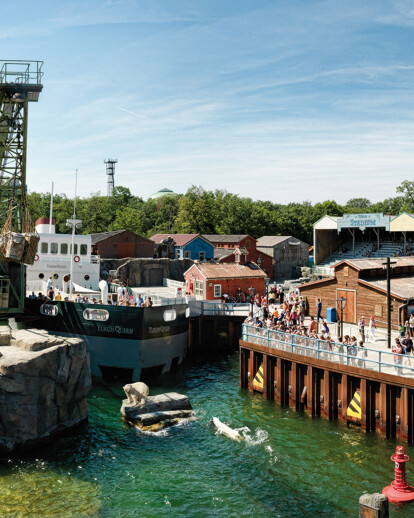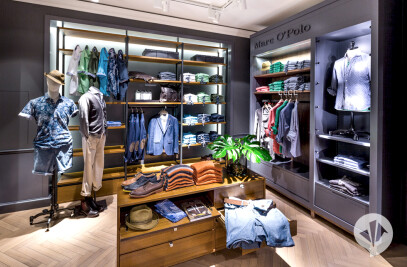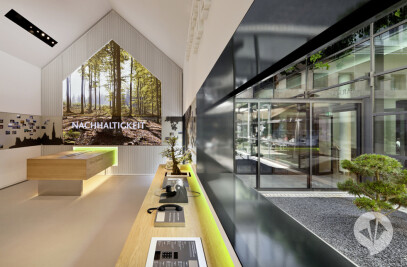Lurking at the far end of the gold mine are the wolves, grazing directly alongside them are the caribou. Not far from the imposing bison herd, prairie dogs dig through the soil. Stretching out before the visitors is the rugged wilderness of Canada with its rocky landscape, its forests, gorges and caves. The little town of Yukon Bay, once founded by gold miners, quickly announces itself. At its centre, on the market square, a colourful hustle and bustle of activity prevails. Inside the former market hall for fish, Mike, the child of German immigrants, serves fish & chips and juicy burgers to hungry travellers. At Mama Mia, pasta simmers away in the pots, and for dessert Luigi Amarone offers up the best Italian ice cream. The old cargo ship the Yukon Queen is moored in the harbour. Seals romp around in front of the grandstand on one side, while the other side is home to the polar bears and, on the deck of the ship, the penguins. The immersive environment of Yukon Bay kept us busy for nine years, from the initial designs to its opening in 2010. As general planner we were not only responsible for designing the architecture and landscape, communications, F+B services and the shop, but we were also contracted to handle all other planning services as well. A BIT MORE DETAIL
1995 marked the beginning of an EXPO project with the ‘Zoo of the Future’ master plan, the bold restructuring of Hanover Zoo. Over a fifteen-year period an adventure zoo took shape in the regional capital of Lower Saxony. The zoo takes seriously its responsibilities as a location for species conservation, education and research, but also sees itself as a recreational facility, promising relaxation and entertainment. Visitors to Hannover Adventure Zoo are thrust into six immersive environments featuring a variety of architecture and landscapes designed in a consistent style. Yukon Bay is the most recent immersive environment to be created in this context. The aim was to design a new habitat for the zoo’s Nordic animals, one as true-to-life as possible while also conforming to the most stringent zoological requirements and promoting thrilling encounters with the animals. Story building played an important role in the planning process. It’s the story behind the penguins living in Yukon Bay that makes their presence plausible. Captain Henry Charters, who travelled the seas of the world with his cargo ship, one day ran his ship aground close to his home port. He had a colony of penguins with him on board. The Yukon Queen was still salvageable and was towed to port; the captain retired and opened up the northernmost penguin zoo in the world. The relatively small surface area presented a major challenge for us early on. To meet the requirements of the immersive environment and give the animals their due, we designed things so that in some cases the spaces serve two purposes. Each structural element performs several functions. The caribou enclosure, for example, is situated on top of the gold mine, which leads visitors into Yukon Bay. The backside of the grandstand with its colourful row house facade and retail space for ice cream and popcorn sets the stage for visitors arriving in the gold rush town. The area below the seats also serves as the manufacturing location for the Luigi Amarone ice cream brand. The steam-powered locomotive at the station or the mine cart rail system are more than just decoration: the former acts as a gate, the latter as a prominent barrier for the polar bear enclosure. Fourteen buildings were erected in a variety of construction modes, from solid wood to reinforced concrete, and from masonry structures to constructions built entirely in steel. So that Yukon Bay City exudes the charm of former gold rush eras, all facades and visible elements were artificially weathered. The facade of the Grand Theatre Palace was even accurately modelled after the theatre of the same name in Dawson City. And inside the market hall, which today has a 480-person capacity, traces of former fish auctions can still be found. The buying and selling of fish once dominated the market place in the harbour, today only the smell of saltwater hangs in the air. The view looks out over the harbour and the polar bear enclosure, whose barriers are barely perceptible as such. The harbour seawall is also a protective structure, carefully designed to take into account factors such as the size, strength, and agility of man and animals, the maximum height of waves in the harbour basin, as well as the risk of falling objects. This is not the only location where the barriers to the enclosures disappear from view. Large panoramic windows provide unique viewing opportunities for observing the wolf pack and impressive views of the seal, penguin and polar bear tank are possible from inside the hull of the Yukon Queen. With Yukon Bay we created a highly complex immersive environment. In total, 15,000 cubic meters of earth were moved, 1,200 tons of steel installed, 13,000 cubic meters of concrete poured, 39 special glass panes for above- and underwater views constructed, 200 tons of small and 400 large natural stones placed, 200 trees and 18,000 shrubs and bushes planted. Over sixty construction companies worked behind the scenes laying 10 km of communications cables and 30 km of power cables.

































